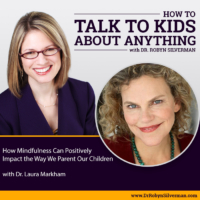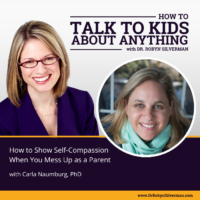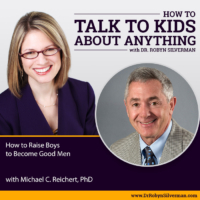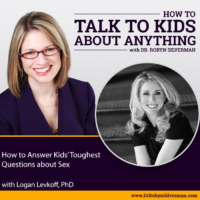Podcast: Play in new window | Download
Subscribe: Apple Podcasts | RSS | More
How to Show Up for Our Children
This podcast episode focuses on how we can show up for our children. This is broken down into the 4 Ss—helping kids feel safe, seen, soothed—and secure! When we show up, the brains are built and our relationships get stronger. While there are so many demands on parents—the most important part of being a parent is showing up physically and emotionally for our children so they learn to show up for others and show up for themselves.
Special Guest: Tina Payne Bryson, PhD
Parenting encapsulates so many different aspects of care when it comes to a child. We receive messages about 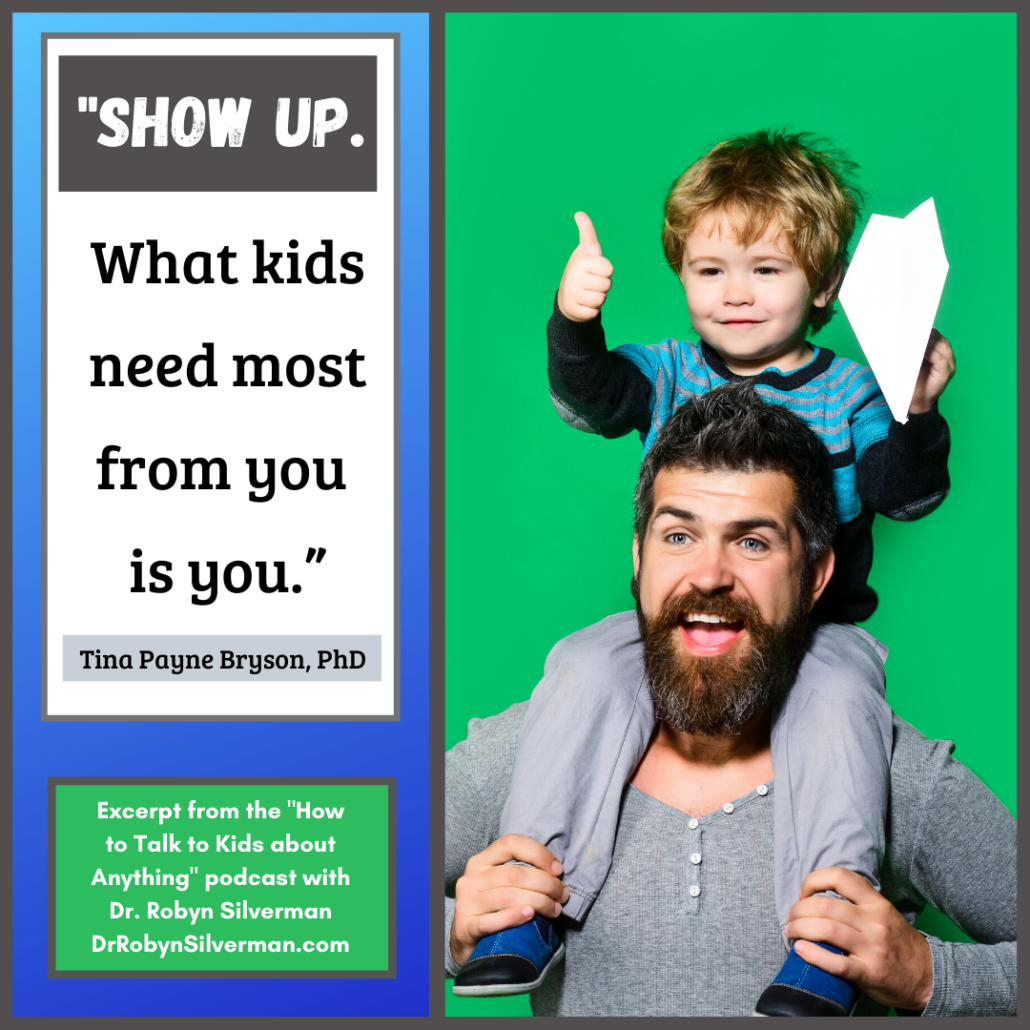 paying attention to how children are doing in school, with friends, what they are eating, how much they are playing, how hard they are working, if they are reading enough, sleeping enough, getting outside enough and much, much more. And while all of this is important—what do you think is the most important thing that a parent can do to make the biggest difference in the long run? The research tells us, it’s all about showing up. In fact, studies show that the best predictors for how any child turns out in terms of happiness, academic success, leadership skills and strong relationships is whether at least one key adult in the life of a child has consistently and predictably shown up for them physical AND emotionally. So today, we are going to hone in on exactly how we can show up for the children in our lives so that they can thrive. For this conversation, we have invited best-selling author, Tina Payne Bryson, on the show today.
paying attention to how children are doing in school, with friends, what they are eating, how much they are playing, how hard they are working, if they are reading enough, sleeping enough, getting outside enough and much, much more. And while all of this is important—what do you think is the most important thing that a parent can do to make the biggest difference in the long run? The research tells us, it’s all about showing up. In fact, studies show that the best predictors for how any child turns out in terms of happiness, academic success, leadership skills and strong relationships is whether at least one key adult in the life of a child has consistently and predictably shown up for them physical AND emotionally. So today, we are going to hone in on exactly how we can show up for the children in our lives so that they can thrive. For this conversation, we have invited best-selling author, Tina Payne Bryson, on the show today.
Tina Payne Bryson, Ph.D., is the founder and executive director of The Center for Connection, a multidisciplinary clinical practice, and of The Play Strong Institute, a center devoted to the study, research, and practice of play therapy through a neurodevelopmental lens. She is a licensed clinical social worker, providing pediatric and adolescent psychotherapy and parenting consultations. Dr. Bryson keynotes conferences and conducts workshops for parents, educators, clinicians, and industry leaders around the world. She is the co-author, with Dan Siegel (who has also been on the How to Talk to Kids about Anything podcast), of The Yes Brain and the New York Times bestsellers The Whole-Brain Child and No-Drama Discipline, as well as the upcoming Bottom Line for Baby. She earned her Ph.D. from the University of Southern California and lives in Los Angeles with her husband and three children.
The podcast provides:
- The keys to showing up for our children
- How to help our children feel safe—without overparenting or underparenting
- How to help our children feel seen even when they are different from us or we don’t agree with their behavior
- How to help our children feel soothed when they make a mistake or have an emotional injury
How to help kids feel secure so they carry that sense with them into other relationships in the future—and they ensure that they show up for themselves as well
Important Messages:
- Many parents are on one or the other end of the pendulum- either hyperparenting or are distracted or
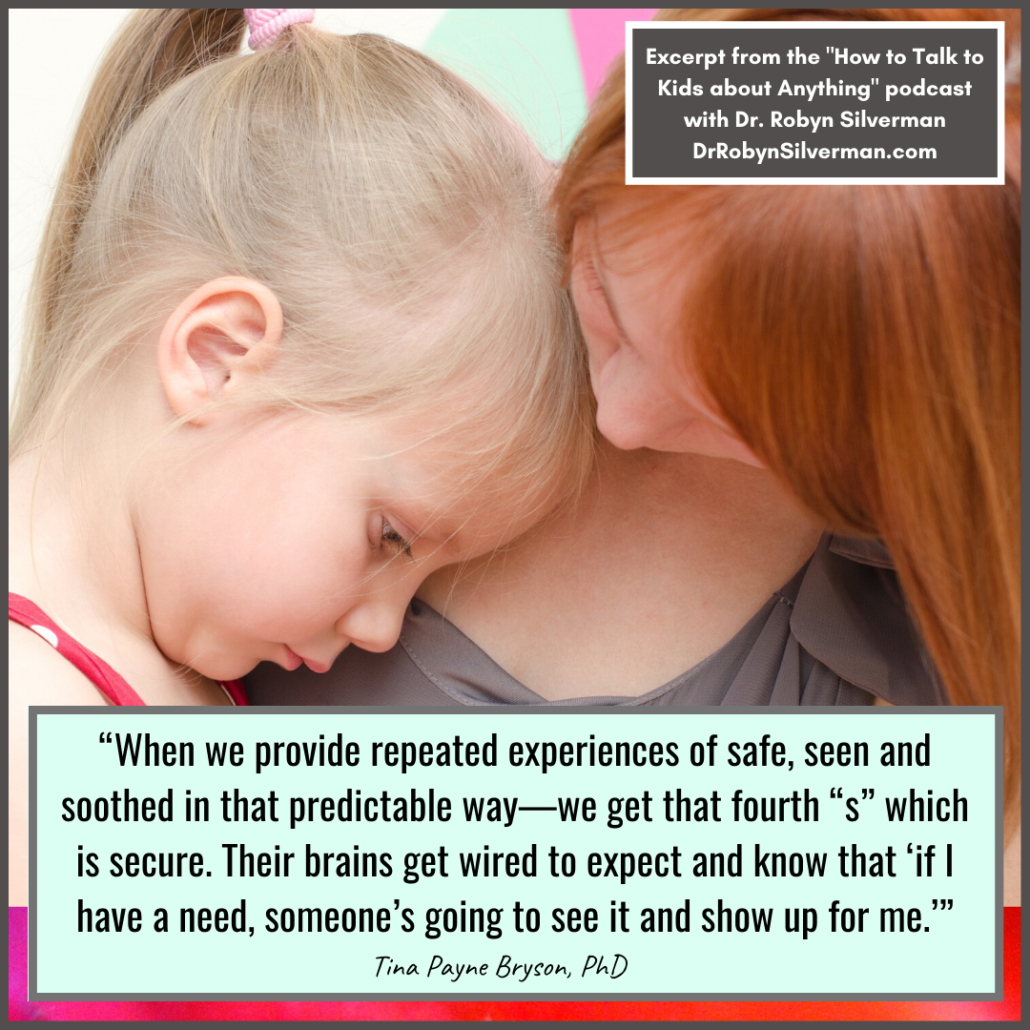 checked out- what are kids need most from their parents is for us to show up. Be present.
checked out- what are kids need most from their parents is for us to show up. Be present. - How? Safe, seen, soothed.
- How do we help kids feel safe? When we overprotect, we actually communicate to them that the world is a dangerous place and that they are vulnerable. This actually is the opposite of safe.
- Safety: (1) Physically safe (i.e. safe around water, buckled into care seat) and (2) Not being the source of our child’s fear (i.e. abuse, neglect, and more mild ways- fighting with a significant other, unpredictable, screaming/yelling). Primary function of attachment. Afraid or hurt- go to attachment figure. Problematic when your attachment figure is the source of your fear. If a problem, reach out for help.
- BUT- if we yell at our kids, we can repair. Build’s resilience IF you make a repair. “My anger really got the best of me, I wish I handled that differently. I shouldn’t have taken it out on you. You don’t deserve that. I’m really sorry.” Kids learn that relationships are messy. Sometimes we treat each other in ways that are not ok AND we get through it. We come together. If you are always lovely, the world would be a scary place because kids wouldn’t learn how to cope!
- Safety is about communicating to our children that we trust that they can handle something- and when they can’t, we will walk with them through it.
- Be predictable. Boundary setting. Not permissive. When kid is devastating. “This is really hard. This was really disappointing and I’m right here with you as you feel disappointed.”
- Reactive behavior- don’t want us to do this. Embarrassed, and feel that they’ll be treated differently. Time to advocate sometimes- but often not time to do vigilantly justice. Doesn’t help kids feel safe. Instead. Script: “That must have really hurt your feelings. How do you feel about that? How are you going to be a problem-solver? I can help you come up with some ideas.” Don’t be a bulldozer.
- Seen: We may have experienced growing up “being seen and not heard” and have to create a new normal. Wanting kids to achieve- can blind us to who are children really are.
- Look with more than your eyes. Mindsight. See your mind in the mind of others. Make sense- be curious about what your child’s experience of a particular situation.
- Example: Doesn’t want to get in or out of the bath. Meltdown. If you just look at behavior and not really “seeing” your child, you might say; “I’m not really sure what you’re so upset about. You were mad about getting in and now your mad about getting out? You’ve got to get out of the bath tub right now. I don’t want to hear it! It’s time for bed!” Instead. Seen: “I see that you are really bummed about bath time being over. You are really having fun and you don’t want bath time to be over, is that right? You are so disappointed (not that you are saying it’s ok to stay in). “I need you to get out or I’ll help you get out.” It’s about tuning in.
- Biggest mistakes as a parent: We assume a bad behavior is CHOSEN.
- Example: child making strange faces when someone tried to take a photo. What is this all about? Still doing it even though he gets into trouble. Self conscious kid. He was embarrassed. This is how he dealt with embarrassment.
- Example: Tina’s husband called her- youngest child locked self in bathroom because not getting popcorn at movies. Get curious. “Are you feeling disappointed because you thought you could get popcorn? Hard to feel disappointed. But we can still have fun at the movies.” Try to make sense of what’s going on BEFORE you respond.
- Celebrate child for who they are.
- Use intuition. Put yourself in this position- look at full picture. It’s their experience! Tune in to their experience even if it seems ridiculous. Build circuitry of their brain. What we give attention to gets built in the brain.
- What if your child is really different from you? Different sensory preferences? Loud/soft? Bicycle vs ferari.
- Ask yourself: Who is this kid and how can I give him a response that allows them to, later in life, look back and say, ‘my parents totally got me.’ That they let me be who I am and never made me feel that I should pretend to be something I wasn’t.
- “Feeling felt.” Celebrated for who I am. How give attention to my children.
- Do you check out? Or, put parameters. “I don’t have a lot of time but what you are saying to me is important to me so what do you really want me to know?” Responding but not stopping the world, when you can’t. Join attention with child. Just by giving attention to what they are giving attention to—creates intimacy- makes them feel felt. Feel seen.
- Be aware of yourself- understand where you are coming from and who you are- and understanding that your child may be different from you- giving attention to them for who they are but putting parameters over it because you are honoring who you are.
- Soothe: providing help, comfort for your child. The way we instinctively respond when our child is physically hurt, we want to respond the same way when our child is hurting emotionally.
- When feelings get big- stressful- feel out of control and not safe- if we provide comfort and connection first, then they can move back to soothed place and then can respond better.
- Bath incident: “If you need to cry or yell for a little bit, you can do that, and I’m right here with you.” Part of soothing is just being present.
- When you are about to fall apart or your child is falling apart, get below their eye level. Say 2 things. (1) Empathy/Seen:- you are really mad at me right now or you are really sad about something. (2) Security: “I’m right here with you.”
- Story: Picture for Mom and didn’t want to put it away. Teacher didn’t regulate self. “This picture looks really
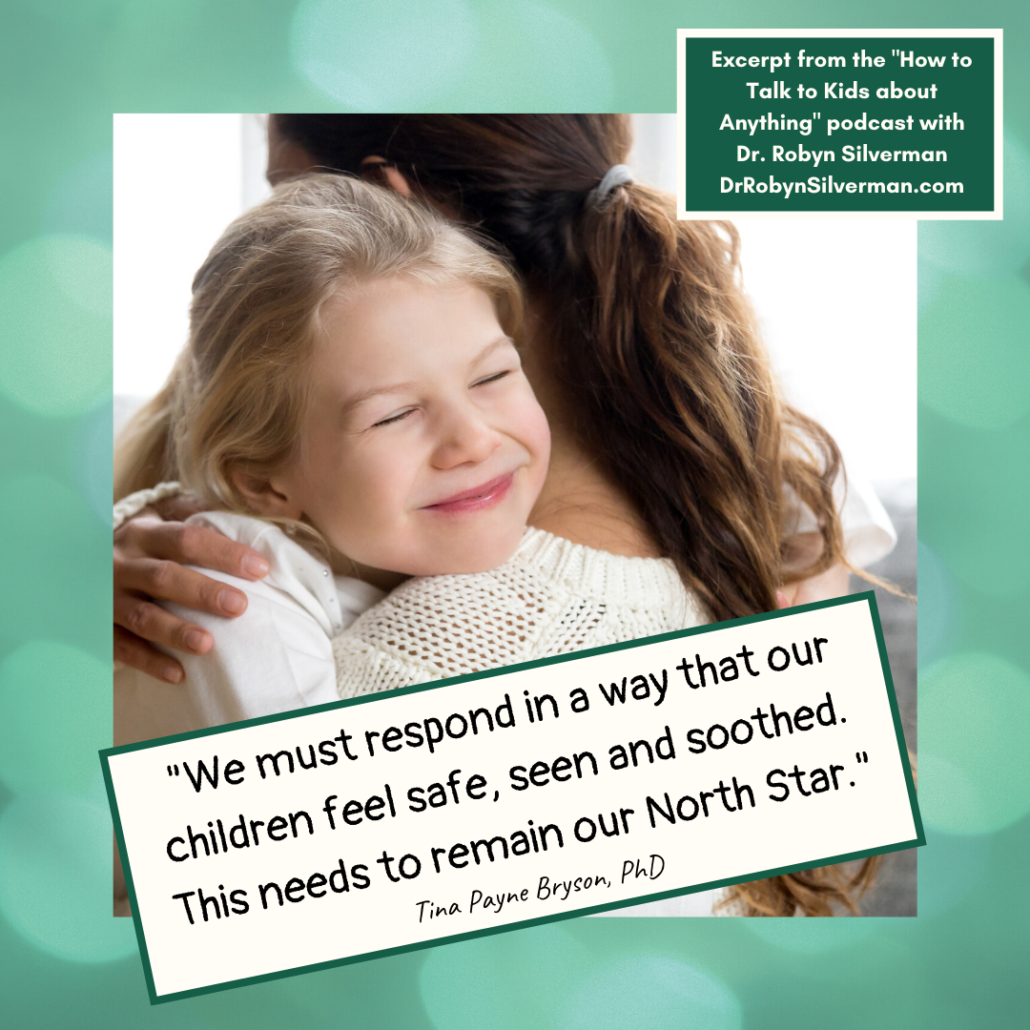 important to you, where should we put it so it’s safe and you have time to work on it later after we come in from recess.” “You are so disappointed! I will help you. I will help you to go outside.” There still may be moments when you have to take the crayon and the paper. You can’t have a reflective dialogue in every everyday moment. Don’t join the chaos. Sometimes you just need to leave. “Aw, you really were having fun. You are really disappointed we have to leave.” And then go. They feel seen.
important to you, where should we put it so it’s safe and you have time to work on it later after we come in from recess.” “You are so disappointed! I will help you. I will help you to go outside.” There still may be moments when you have to take the crayon and the paper. You can’t have a reflective dialogue in every everyday moment. Don’t join the chaos. Sometimes you just need to leave. “Aw, you really were having fun. You are really disappointed we have to leave.” And then go. They feel seen. - Tune in. Your child may be falling apart but YOU don’t have to fall apart.
- Research is clear- when we help kids to come back to the calm state when upset, integrated brain, their brain gets practice. Promotes independence.
- When we provide repeated experiences of safe, seen and soothed in that predictable way—we get that fourth “s” which is secure. Their brains get wired to expect and know that ‘if I have a need, someone’s going to see it and show up for me.’ Then they expect it in other relationships- and they expect it in themselves. They show up for themselves. They can see themselves. They can soothe themselves. They can show up for themselves.
- Help the other person to feel safe, seen and soothed, is the north star. Respond in a way that your child feels safe, seen and soothed.
- Find ways to make sure you find other people who show up for you.
Notable Quotables:
- “We are training the next generation of grown-ups.”
- “Show up. What kids need most from you is you.”
- “Safety is about communicating to our children that we trust that they can handle something- and when they can’t, we will walk with them through it.”
- “The stakes are really high with overparenting– when we really want our children to achieve and that can really blind us from seeing who our children really are.”
- “One of the biggest mistakes we make as a parent is that we assume that a bad behavior is chosen- sometimes it is- but often their nervous is in reactive mode or they are trying to make sense of the world.”
- “What we give attention to gets built in the brain.”
- “Who is this kid and how can I give him a response that allows them to, later in life, look back and say, ‘my parents totally got me.’”
- “The research is clear. When kids get repeated experiences when falling apart and we help them come back to a calm, receptive state again, their brain gets practice for how to do that. When we show up in very nurturing ways, it actually promotes independence and resilience because their brain has had practice doing that.
- “When we provide repeated experiences of safe, seen and soothed in that predictable way—we get that fourth “s” which is secure. Their brains get wired to expect and know that ‘if I have a need, someone’s going to see it and show up for me.’”
- “When we show up, it builds our children’s brains and it builds are relationship with them.”


